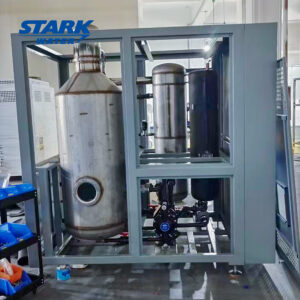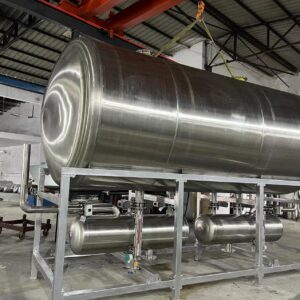 Low Temperature Vacuum Evaporator
Low Temperature Vacuum EvaporatorLow Temperature Vacuum Evaporator
Efficiently concentrate liquids and treat complex wastewaters with Stark Water’s Low Temperature Vacuum Evaporator. This advanced low temperature vacuum evaporator utilizes vacuum technology to evaporate water at reduced temperatures, ideal for heat-sensitive materials and achieving high concentration with significant energy savings.
Opis produktu
In various industrial processes, concentrating liquid solutions or treating wastewater containing heat-sensitive components, high boiling point solvents, or valuable recoverable materials presents a significant challenge for conventional evaporation methods. High temperatures can degrade sensitive products, consume excessive energy, and often fall short of desired concentration levels. The Low Temperature Vacuum Evaporator is a state-of-the-art solution specifically designed to overcome these hurdles, offering an efficient, gentle, and energy-saving method for liquid concentration and advanced wastewater treatment.
The Innovative Principle of Low Temperature Vacuum Evaporator
The core innovation of a low temperature vacuum evaporator lies in its ability to significantly reduce the boiling point of water or other solvents by operating under vacuum conditions. At atmospheric pressure, water boils at 100°C (212°F). However, under a vacuum, the boiling point can be lowered drastically, often to temperatures as low as 30-40°C (86-104°F) or even lower, depending on the vacuum level. This principle allows for the evaporation of water or solvents at temperatures that are gentle enough to preserve heat-sensitive materials, making it ideal for industries like pharmaceuticals, food & beverage, and fine chemicals. The evaporated vapor is then condensed, recovering pure distillate water, while the concentrated liquid (or sludge) remains.
Key Benefits for Complex Liquid Concentration and Wastewater Treatment
The application of a low temperature vacuum evaporator brings a multitude of advantages to industrial processes:
- Preservation of Heat-Sensitive Materials: Gentle operating temperatures prevent thermal degradation of valuable or delicate components in the solution, maintaining product quality and efficacy.
- Significant Energy Savings: Lower boiling points require less heat input, leading to reduced energy consumption (often utilizing waste heat or heat pumps for further efficiency) compared to atmospheric evaporation.
- High Concentration Factors: Capable of achieving very high concentration ratios, minimizing the volume of waste requiring disposal or maximizing the recovery of concentrated products.
- Treatment of Challenging Wastewaters: Effectively treats industrial effluents with high TDS (Total Dissolved Solids), heavy metals, complex organic pollutants, or high COD/BOD, converting them into pure distillate and concentrated residue.
- Resource Recovery: Enables the recovery of valuable components (e.g., salts, chemicals, active ingredients) from waste streams, transforming waste into usable resources.
- Reduced Wastewater Disposal Costs: By drastically reducing the volume of liquid waste, disposal costs are significantly minimized.
Stark Water’s Low Temperature Vacuum Evaporator is engineered with precision heat exchangers, robust vacuum systems, and automated controls to ensure continuous and efficient operation. Its modular design allows for customization based on specific evaporation capacity and liquid characteristics.
Parametr produktu
The Stark Water Low Temperature Vacuum Evaporator is engineered for efficient, gentle, and high-performance liquid concentration and wastewater treatment. Here are its key technical specifications:
| Parametr | Specyfikacja / opcje dostosowywania |
|---|---|
| Główne słowa kluczowe | Low Temperature Vacuum Evaporator design and capabilities. |
| Evaporation Capacity | Customizable, ranging from 0.1 m³/day to 50+ m³/day (approx. 26 GPD to 13,000+ GPD). Specified based on client’s requirements. |
| Operating Principle | Vacuum Evaporation (boiling point depression). |
| Operating Temperature (Evaporation) | Typically 30°C – 80°C (86°F – 176°F), depending on vacuum level and liquid properties. |
| Vacuum Level | Customizable, typically -0.08 MPa to -0.098 MPa (absolute pressure as low as 2 kPa – 20 kPa). |
| Heat Source | Steam, Hot Water, Waste Heat, Electricity (via heat pump evaporator), or combination. |
| Heat Exchange Area | Designed based on evaporation capacity and specific heat transfer coefficients of liquid. |
| Distillate Quality | High purity, typically <100 ppm TDS, suitable for reuse or discharge. |
| Concentrate Output | Highly concentrated liquid/sludge, significantly reduced in volume. |
| Materiał konstrukcyjny | Stainless Steel (SUS304, SUS316L, Duplex SS, Titanium) for evaporator body, heat exchanger, and pumps. Chosen based on liquid corrosivity. |
| System kontroli | Fully Automatic PLC Control with HMI, real-time monitoring of temperature, pressure, flow, level, and alarm functions. Remote control available. |
| Energy Consumption | Highly efficient, particularly with mechanical vapor recompression (MVR) or heat pump technology. Specific energy consumption (SEC) can be as low as 15-50 kWh/m³ of evaporated water. |
| Zasilanie | 3-fazowy, 380V/415V/460V, 50Hz/60Hz (konfigurowalny). |
| Wymiary | Customized skid-mounted or modular design, based on capacity. |
| Zgodność | Designed to relevant industry standards and safety regulations. |
Obowiązująca branża
The Stark Water Low Temperature Vacuum Evaporator is a versatile and indispensable solution for industries requiring efficient concentration of heat-sensitive liquids, advanced treatment of complex wastewaters, or valuable resource recovery. Its unique operating principle makes it ideal for:
- Pharmaceutical Industry: Concentrating active pharmaceutical ingredients (APIs), herbal extracts, and other heat-sensitive pharmaceutical solutions without degradation; treating pharmaceutical wastewater.
- Food & Beverage Industry: Concentrating fruit juices, dairy products (milk, whey), coffee extracts, flavors, and other food liquids while preserving taste, aroma, and nutritional value; treating high-BOD/COD food processing wastewater.
- Chemical Industry: Concentrating various chemical solutions, recovering valuable solvents, or treating complex chemical wastewaters containing high salts, heavy metals, or organic pollutants.
- Landfill Leachate Treatment: Highly effective for treating challenging landfill leachate with high TDS, COD, and heavy metals, enabling pure distillate reuse or safe discharge.
- Electroplating & Metal Finishing Industry: Recovering valuable metals from rinse waters and concentrating spent plating baths, reducing waste volume and achieving zero liquid discharge (ZLD).
- Power Generation: Treating cooling tower blowdown, flue gas desulfurization (FGD) wastewater, and other high-TDS power plant effluents.
- Mining & Metallurgy: Concentrating mineral solutions, recovering valuable metals from tailings, and treating mining wastewater.
- Textile & Dyeing Industry: Treating highly colored and high-COD wastewater from dyeing processes, allowing for water reuse and concentrated dye recovery.
- Biotechnology: Concentrating fermentation broths, enzyme solutions, and other biological products sensitive to high temperatures.
- Wastewater Treatment (Industrial): A robust solution for achieving Zero Liquid Discharge (ZLD) or near-ZLD for various industrial wastewaters by producing high-quality distillate and highly concentrated residue.
Advantage One
Przewaga DWÓCH
Powiązane produkty
Podobne produkty
FAQ
P1: Jak długo działa system odwróconej osmozy?
Żywotność systemu odwróconej osmozy zależy od jakości wody i konserwacji. Zazwyczaj membrana wytrzymuje 2-3 lata, podczas gdy sam system może wytrzymać ponad 10 lat przy odpowiedniej pielęgnacji.
P2: Czy system można dostosować do różnych warunków wodnych?
Tak, wszystkie nasze systemy są w pełni konfigurowalne. Analizujemy raporty wodne i potrzeby aplikacji przed dostarczeniem dostosowanych rozwiązań.
P3: Jakie standardy spełnia sprzęt STARK?
Nasze produkty są zgodne z normami CE, ISO 9001, a na życzenie mogą być zaprojektowane tak, aby spełniały określone przepisy regionalne lub normy branżowe.
P4: Jaki jest czas dostawy systemów STARK RO?
Standardowe systemy są wysyłane w ciągu 7-15 dni. W przypadku niestandardowych zamówień czas realizacji może wydłużyć się do 20-25 dni w zależności od złożoności.
P5: Czy zapewniasz wsparcie techniczne lub wskazówki dotyczące instalacji?
Tak. Zapewniamy pełną dokumentację techniczną, zdalne wskazówki za pośrednictwem wideo, a na życzenie możemy wysłać inżynierów za granicę.
P6: Co jest zawarte w wycenie?
Nasza oferta obejmuje kompletny system RO, panel sterowania, pompy, jednostki oczyszczania wstępnego i wszystkie niezbędne elementy. Narzędzia instalacyjne i części zamienne mogą być dołączone na życzenie.








